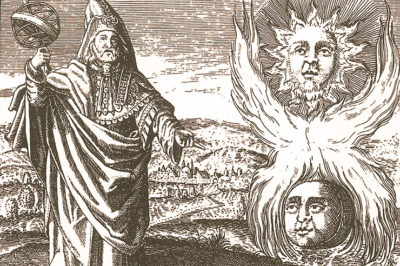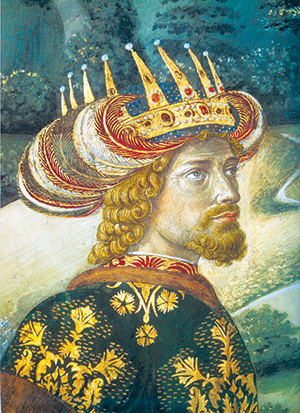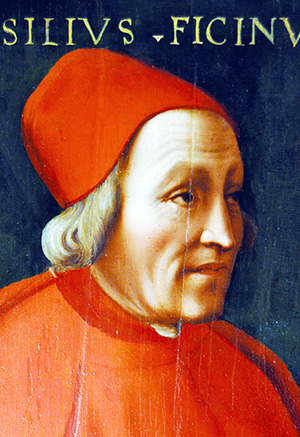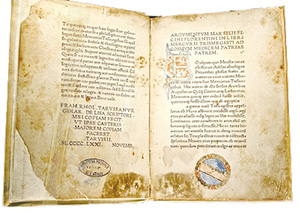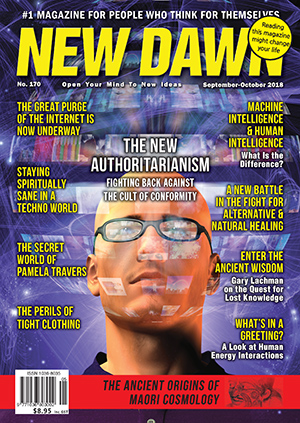From New Dawn 170 (Sept-Oct 2018)
The Council of Ferrara-Florence, held from 1438 to 1445 in, not surprisingly, the Italian cities of Ferrara and Florence, had as one of its main objectives the possible reunion of the two branches of Christianity, Roman Catholic and Orthodox Byzantine, that had been separated since 1054. Agreement over doctrinal differences was not the guiding principle of the proposed merger. The true motive was realpolitik. The Turk was edging closer to Constantinople, and the Greek Orthodox Church knew it needed help to keep him at bay. When Emperor John VIII Palaeologus decided to put together a crack team of negotiators to plead the Byzantine church’s case, he included among his top men someone from outside the fold, a secular thinker he respected. Some thought this strange. Yet the appearance at the Council of the emperor’s man turned out to be one of the most important events in what we can call the “secret history” of the West.
Who was this mystery man and why was his participation in the Council so important? It certainly wasn’t because of his ostensible reason for being there. The Council itself was a failure. The two churches did not reunite and less than a decade later, just as the emperor feared, the Ottomans overran Constantinople. Oddly enough, the ransacking of the Byzantine capital by the Turk was itself a major factor in the same secret history for which the Council of Ferrara-Florence set the stage.
The mystery man in question was the Byzantine Neo-Platonic philosopher George Gemistos Plethon. It wasn’t in fact until he attended the Council that he took or was given the name Plethon. This was a variant on the name of a philosopher who was still something of a mystery himself at the time, Plato. Why Gemistos took the name of the father of Western philosophy will become clear as we go along.
Gemistos was born in 1355 in Constantinople to a well-off family who had him educated there and in Adrianople. Adrianople at the time was the capital of the Ottoman empire and had become an important centre of learning. Gemistos must have been something of a prodigy; he was said to have accompanied the emperor on a visit to western Europe when he was in his teens and seems to have been primed to become a teacher of philosophy. In this regard, Gemistos was lucky to be born in Constantinople. After the fall of the pagan world and the onset of the Dark Ages, more of Greek philosophy survived in the eastern empire than in the west. What there was of it that he could find, Gemistos absorbed greedily.
Gemistos was a passionate lover of the ancient world and devoted student of Plato; in the Aristotelian atmosphere of the Orthodox – and Catholic – church, this held certain dangers. While Aristotle could be harnessed for the church’s purposes, Plato was seen as a threat. But Gemistos’ Platonising also meant that his learning, wisdom, and dialectical skill were highly prized. Hence, the decision of John VIII Palaeologus to send him to the Council. Gemistos was an old man by then – he lived to be nearly 100, amazing for the time – but in many ways it was the defining event of his life.
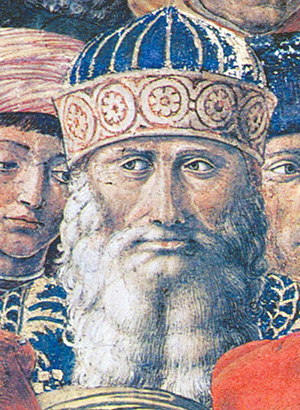
Gemistos had no appetite for doctrinal disputes; he also had no love of the Catholic church although he did his best to get it on Constantinople’s side. When his services were not needed, he let his companions split dogmatic hairs while he killed time by giving lectures on Plato, Aristotle, and a strange idea that he had retrieved from his studies of a mystical text known as the Chaldean Oracles. This was what he called the prisca theologia, a “primal” or “ancient theology,” the fundamental knowledge of God, that had been revealed to mankind in the dim past, but which had, over the centuries, become obscured.
Gemistos believed that the Chaldean Oracles had been written by one of the sages to whom this ancient wisdom had been given, the Persian Zoroaster, who lived in the dim past and who had himself passed this wisdom on to those who came after him. Sadly, Gemistos was wrong about Zoroaster – at least about him being the author of the Chaldean Oracles. Today we are fairly sure that these strange texts were actually written in second-century Rome by a family of magicians and seers known as the Juliani, who used various forms of what we would call mediumship and trance states to produce them.
For Gemistos the Oracles were a fount of the primal theology, the ancient wisdom that had been vouchsafed to man before the Flood. Since that time it had been kept and periodically disseminated by what became known as the aurea cantena or “golden chain of adepts,” a lineage of secret teachers whose mission it was to pass on the ancient wisdom to those who could grasp it. Plethon’s own stream of transmission had Zoroaster at the start, with Eumolpus – the founder of the Eleusinian Mysteries – King Minos of Crete, the oracle of Dodona, Chiron, the wisest of centaurs, the Seven Sages, as well as Pythagoras, Plato, Plotinus, and his disciples Porphyry and Iamblichus, following after him.
Gemistos enjoyed lecturing on the ancient wisdom and its teachers, but as the Council dragged on, he left Florence and returned to his home in Mystras, near ancient Sparta, where he began a kind of “mystery school.” He also devised a plan to reorganise the failing Byzantine empire along the lines of Plato’s Republic, wrote about the need to revive the pagan religions, and produced studies of Neo-Platonism, astrology, Hindu philosophy and Sufism. He seemed to have a premonition of a coming crisis and wanted to preserve what he could of his beloved ancient past. He died in 1452. A year later Gemistos’ premonition proved correct. Constantinople fell, and as the Turk entered the city, scores of Christian Greek scholars fled, selling off their libraries to fuel their departure.
Marsilio Ficino
One of the people who had heard Gemistos lecture while he was in Florence was Cosimo de’ Medici, the city’s great power broker. The Byzantine’s words had inspired him. Gemistos’ championing of Plato and, even more, his belief in the “ancient wisdom” of which Plato himself was a student, had fired Cosimo’s soul. So inspired was Cosimo that he decided to revive the Platonic philosophy right there in Florence. The best way to do this, Cosimo saw, was to reopen the Platonic Academy, which had been closed for business since the Emperor Justinian I shut its metaphorical doors in 529, effectively calling time on the pagan world. Luckily for Cosimo, just the man for the job was close at hand.
Marsilio Ficino was a young Florentine Greek scholar, and after an interview with him, in 1462 Cosimo entrusted to him the newly revived Platonic Academy, putting all he needed for it at his disposal. Along with a villa in the hills above Florence, Cosimo, an obsessive book collector, gave Ficino access to his library. Recently, precisely because of the fall of Constantinople, many items previously unavailable in the west had come on the market, and several works by Plato had been snatched up by Cosimo’s book scouts. Cosimo hoped to read these as soon as possible, so he put Ficino on the job of translating them into Latin. No sooner had the young scholar got down to work than his boss told him to delay that order. Something else, more important than Plato, had come into his possession. Ficino had to put the father of philosophy aside and get to work immediately on this.
What could have been so important that it forced Plato into the backseat? None other than the Corpus Hermeticum, the collection of mystical, magical, and metaphysical writings that were attributed to the greatest sage of the antediluvian world, Hermes Trismegistus, fabled “thrice greatest Hermes.” Hermes, an even more misty figure than Zoroaster – he is in fact an amalgam of the Egyptian god of magic Thoth and the Greek god of writing Hermes, born in ancient Alexandria – was considered to be even more important or fundamental a secret teacher than the great Persian sage. When Cosimo heard that a collection of these texts had come into his possession, he told Ficino to get them into Latin post haste. By one of those twists of fate that suggest some guiding hand at work, the very catastrophe that Gemistos Plethon, teacher of the ancient wisdom, had tried to prevent, led to perhaps the greatest work in this tradition coming to the mind most ready at that time to appreciate it and, more importantly, to pass it on.
Ficino put down Plato and picked up Hermes. Soon his Latin translations of these primordial texts were informing the shift in western consciousness that we know as the Renaissance. In school, we are taught that the Renaissance was about the rediscovery of the great works of ancient philosophy, such as Plato’s dialogues, and the birth of humanism, the belief in humanity as something more than a race of wretched sinners. This is true. But as the historian Frances Yates argued in Giordano Bruno and the Hermetic Tradition, it was also as much about the rediscovery of the Hermetic texts, and Ficino’s belief that they presented the very prisca theologia and “ancient wisdom” which Plato and the whole aurea catena had called upon since time immemorial.
Along with informing and inspiring works such as Botticelli’s Venus and Michelangelo’s masterpieces, among others, what is remarkable about the Hermetic Renaissance is that for a time, Hermes Trismegistus was considered a kind of precursor to Christ or at least a very important fellow traveller. There were influential people within the church who argued for the “ancient wisdom” to be incorporated into church teaching. I tell this story, along with that of the Corpus Hermeticum itself, in my book The Quest for Hermes Trismegistus. One product of this sadly unsuccessful attempt to unite the ancient wisdom with Christianity – which devotees of the prisca theologia believed was an expression of the ancient wisdom itself – was what has become known as the philosophia perennis, or “perennial philosophy.”
The Perennial Philosophy
This term was coined in 1540 by the humanist, biblical scholar and Catholic apologist Agostino Steuco, to account for the harmony he and many others saw among Christianity, pagan philosophies, and the Hermetic teaching, and which argued that they should be united and not antagonists. This was further extended to include the differences between Protestant and Catholic, Aristotle and Plato, Jew and Christian, and has since come to mean a central timeless spiritual teaching from which all religions, including those of the East, emerge. Steuco’s arguments convinced others, such as François Foix de Candale, Bishop of Aire, who believed that the Hermetic writings should be made canonical, and the Venetian philosopher Francesco Patrizi, who petitioned Pope Clement VIII to have Hermetic ideas taught in Christian schools. Although the notion made some headway, in the end the church insisted that Christianity, rather than being the best or most perfect expression of this perennial wisdom – as its advocates needed to concede – was unique, incomparable, and in a league of its own, and did not need other adepts.
Although clearly similar and often used interchangeably, there is nevertheless a difference between the ancient wisdom and the perennial philosophy. The difference lies in the ancient wisdom positing a historical revelation, a “giving” of this knowledge to mankind in the dim past, which has subsequently become obscured over time. Hence the Renaissance obsession with the “source” or “fount” of wisdom, which it considered the purest expression of it, rather as a mountain stream is clearest at its source, not muddied as it gets into the lowlands. Hence also the belief that what is oldest is best, and the prestige given to the Corpus Hermeticum, which was believed to have been written before the Flood. For a culture coming out of the Dark Ages, such an appetite for the “real thing” is not surprising.
For the perennial philosophy, however, the source is not that important because it is always present; it is a-temporal. It does not lie in the vaults of time but in the Eternal Now. We can say it presents an “evergreen wisdom” rather than an ancient one. This is the sense in which it became popularly known and first widely appreciated, through Aldous Huxley’s influential anthology The Perennial Philosophy, which draws on spiritual and mystical texts from all sources – although it must be said that Huxley’s interpretation falls heavily on the side of the East. He also mistakenly credits the philosopher Leibniz with coining the term philosophia perennis. This is understandable, as Leibniz was the first to make it widely known outside the church.
Another school likewise associated with that of the ancient wisdom, which is also different from it, and from the perennial philosophy, with which it is also confused – all three are often mixed and matched – is what is known as Traditionalism. Like the ancient wisdom, Traditionalism posits a “primordial” revelation and also believes that this pristine appearance of sacred Truth has over time become obscured. As does the ancient wisdom, it believes that this revelation is at the heart or essence of the great religions. But where they differ is in Traditionalism’s belief that access to this primordial knowledge can come only through strict adherence to one of the great religious traditions. We can see this as a kind of esoteric fundamentalism. René Guénon, the recognised founder of Traditionalism, sought this “true” stream of knowledge first in Hinduism, then in Islam. That said, other important Traditionalists, such as Frithjof Schuon and Julius Evola, took the idea in directions rather different from Guénon’s, and it is not unusual today for contemporary Traditionalists to follow paths not necessarily laid down by the great religions.
While in its early days, the proponents of ancient wisdom did seek for unity among different beliefs, and adherence to a strict tradition was not part of their method. As in ancient Alexandria, the birthplace of the Hermetic teachings, the Renaissance in which these teachings re-emerged was a melting pot of different ideas and visions, and the synthesis of these was of more importance than any putative purity – see, for example, Pico della Mirandola’s Oration on the Dignity of Man. Hence the syncretism characteristic of Alexandria and of the esoteric and mystical teachings that appeared there. It is one of the ironies of esoteric history that Traditionalism, whose roots can be traced back to Ficino’s version of the aurea catena, came to be known as a vociferous condemner of the Renaissance, and a fierce opponent of the “modernity” to which it gave rise, as well as of the syncretism which it saw as the sign of what it called “counter-initiation.” If we can accept the Renaissance as the time when the notion of an ancient wisdom or lost tradition gained intellectual and cultural momentum, then Traditionalists of the “revolt against modernity” school seem to want to pull away at their own roots.
Yet that modernity itself undermined its Hermetic foundations. In 1614 the prestige of Hermes Trismegistus declined when the humanist scholar and church historian Isaac Casaubon declared that, based on the Greek in which the Corpus Hermeticum was written, it could not have been “revealed” to mankind in the misty past, but was most likely produced – as we have subsequently come to accept – in Alexandria circa 100-200 CE. At a single blow, the authority of the ancient wisdom and the Renaissance worship of the oldest as best had the rug pulled out from under them. Although Hermetic thinkers like Robert Fludd fought gallantly against it, with Casaubon’s bombshell the Hermetic philosophy quickly lost its street cred. Now the modern, new, up to date and rigorously “scientific” had pride of place.
What Happened to the Ancient Wisdom?
What happened to the ancient wisdom? For one thing, its links to the philosophia perennis helped in this crisis; if the source of wisdom was ever-present, then fixing it at a one-time-only point in history seems redundant, although its various appearances, at different times and places, could be traced. But perhaps more important, the ancient wisdom went underground. First with the Rosicrucian brotherhood – that mysterious secret society of invisible sages – and subsequently in a variety of forms, which have come down to us as the Western “esoteric,” “mystery,” or “inner tradition,” or, more popularly, “occultism.” This is a body of “rejected knowledge,” jettisoned by the rise of rationalism and, in our time, “scientism,” which insists nevertheless in maintaining its important and indispensable place in the human spiritual economy. In fact, we can say that since the late nineteenth century, the ancient wisdom has been making a fragmentary but persistent comeback, filled with detours, dead ends, and wrong turns, but gaining ground nonetheless.
This began with the most influential appearance of the ancient wisdom in modern times, the founding of the Theosophical Society by Helena Petrovna Blavatsky and her colleagues in 1875, and the mammoth texts Blavatsky produced – Isis Unveiled and The Secret Doctrine – to get the wisdom across to the reading public. As in the Renaissance, Blavatsky and Co. believed that the ancients knew quite a bit that had been forgotten; they also believed that at root all religions share the same source and are moving, however clumsily, in the same direction. Science, in its own befuddled way, is too.
Blavatsky’s ancient wisdom was global; she found it in the rejected Hermetic tradition, and in the Eastern traditions she did so much to translate to the West. After her, others sought this wisdom too, and brought some of it back from their journeys: Rudolf Steiner from the Akashic Record, Gurdjieff from the Sarmoung Brotherhood, Ouspensky from his search for “the miraculous,” to mention only some of the most insightful and influential of those “seekers of truth” that followed, often literally, in Blavatsky’s footsteps. Today, almost a century and a half later, ancient wisdom, perennial philosophies, and a variety of Traditions crowd the electronic noösphere we call the Internet.
And what precisely is the ancient wisdom? That would require another article. But I would think that by now the reader would have enough to find out for themselves.
© New Dawn Magazine and the respective author.
For our reproduction notice, click here.

